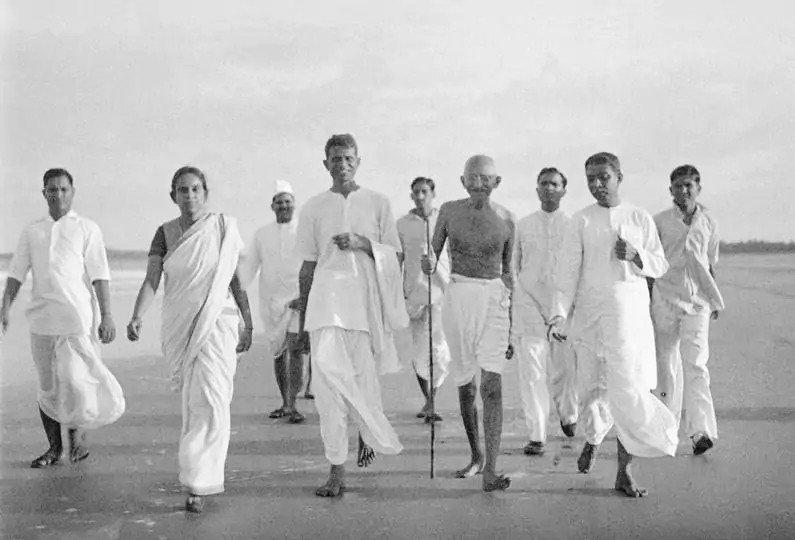Staff in hand, the Mahatma walked every day of his life......A habit that kept his deceptively frail-looking body strong & hardy |
 For most of his adult life, Gandhi weighed around 100 pounds. He was five-feet-five-inches tall (though some accounts put his height at five-feet-four-inches) and his black-and-white photographs give an impression of frailty. But nothing could be further from the truth. All his life, he kept a gruelling schedule. He travelled incessantly, criss-crossing the country on train and foot. He met and corresponded with a bewildering number of people. He edited, published and wrote regularly for journals such as Young India, Navjivan, Harijan. All this apart from leading countrywide mass movements against the British, surviving severe fasts and being sentenced to jail no less than 10 times. None of this would have been possible without enviable reserves of endurance. That spare, thin body in its simple loin cloth, was strong and hardy. French writer and Nobel winner, Romain Rolland, with whom Gandhi corresponded regularly, wrote of him: “This little man, so frail in appearance, is tireless, and fatigue is a word which does not exist in his vocabulary.” Behind this strength lay a lifetime of ascetic eating – and regular physical exercise in the form of walking. On an average, Gandhi walked around 18 km every day for nearly 40 years. (During his campaigns from 1914 to 1948, it is estimated that he walked approximately 79,000 km, which is equivalent to circling the Earth twice.) He once even ticked off the venerable Gopal Krishna Gokhale, who was like a mentor for him, for not walking: “You do not even go out for walks. Is it surprising that you should always be ailing? Should public work leave no time for physical exercise?” he asked. Needless to say, Gokhale’s reply that he didn’t have the time, left Gandhi unconvinced. That was because no matter where he was, or how busy he was, Gandhi never skipped his walks. He realised the importance of walking early on in his life. While studying law in England (1888-91), he initially stayed as a tenant with an English family. But finding himself short of money, he decided to cut his expenses by half. He took independent rooms of his own, selected so that he could walk to his workplace in half an hour: “The new arrangement combined walks and economy, as it meant a saving of fares and gave me walks of eight or ten miles a day. It was mainly this habit of long walks that kept me practically free from illness throughout my stay in England and gave me a fairly strong body.” When he came to Bombay after his stint in London, he lived in Girgaum, but hardly ever took a carriage or tramcar. He would walk to the High Court, which took him 45 minutes, and return on foot as well. This saved him money, since he didn’t have too many briefs. Once again, he says he doesn’t remember falling ill. In England, he had enjoyed walking in the crisp, cool weather; in Bombay, he “inured” himself to the heat. “Even when I began to earn money, I kept up the practice of walking...” In South Africa, he went for regular walks with his friend Hermann Kallenbach. During the satyagraha there, he led striking workers on a 35-mile walk to escape the white owners of mines and plantations. Later in his life, whether he stayed at his ashrams (Sabarmati, Sevagram) or not, walking was an inseparable part of his daily schedule. Even when he was recovering from an appendicitis operation in 1924 in Bombay, he walked for 40 minutes on the Juhu seashore every day. In London in 1931 for the Round Table Conference, he continued to wake up at 4am, pray for an hour, then go for a walk through the deserted streets of the city. Of course, the walk that Gandhi is known for is the great Dandi march, undertaken when the Mahatma was 60-plus. He walked 386 km in 1931 over 24 days, from Sabarmati Ashram to Dandi on the coast, to break the salt law. This was the walk that shook the foundation of the British empire in India. 25 Miles A Day In A War ZoneThe ability to walk long distances took an altogether different turn when Gandhi was in South Africa and war broke out between the Boers and the British in 1899. The Boers, of Dutch extraction, had installed themselves in the Transvaal, next to British-ruled Natal. The discovery of gold in the Transvaal triggered conflict between them. Gandhi, who was in Natal then, volunteered to work in the ambulance corps along with about 500 Indians. He often walked 20-25 miles a day, bearing the wounded on stretchers. It was dangerous work – on occasion, they found themselves working within the firing line, shells crashing around them. Gandhi was once again part of the ambulance corps during the 1906 Zulu revolt, when the Zulus protested against the British over an unjust tax. Gandhi’s heart was with the Zulus and he was glad of the opportunity to nurse them because the whites refused to do so. Their wounds were not from battle. They were mostly from floggings given to Zulu prisoners, wounds that had festered because no one had tended to them. “The white soldiers used to peep through the railings that separated us from them and tried to dissuade us from attending to the wounds. And as we would not heed them, they became enraged and poured unspeakable abuse on the Zulus,” wrote Gandhi. Attached to a swift-moving column, Gandhi writes in his autobiography that on occasion he and his volunteers even walked up to 40 miles a day with stretchers on their shoulders. Courtesy: Hindustan Times, 28th September 2019 |